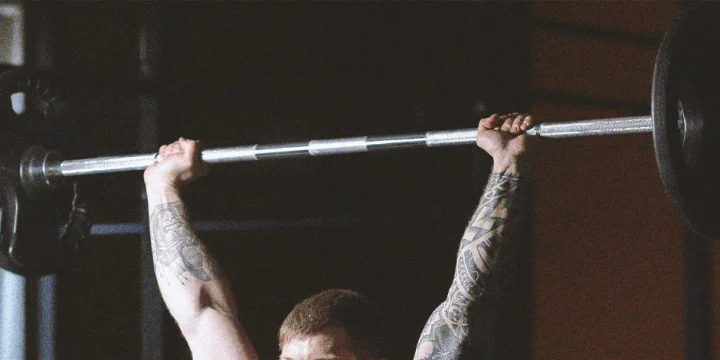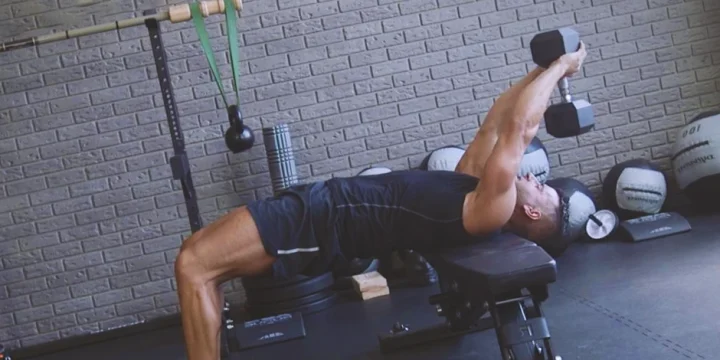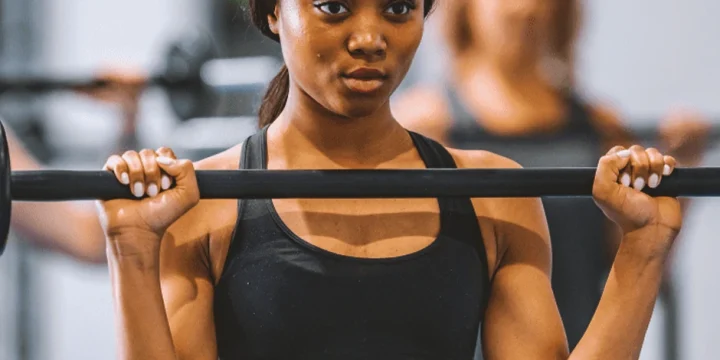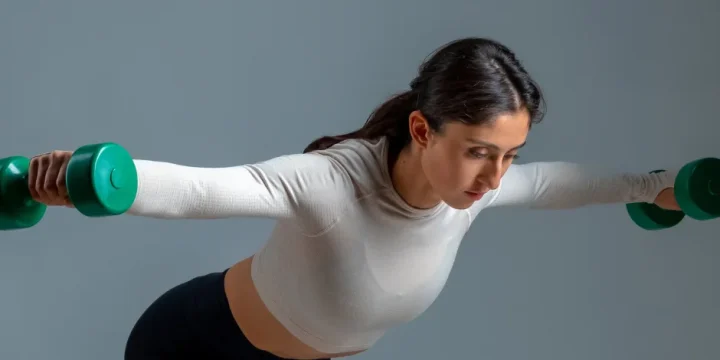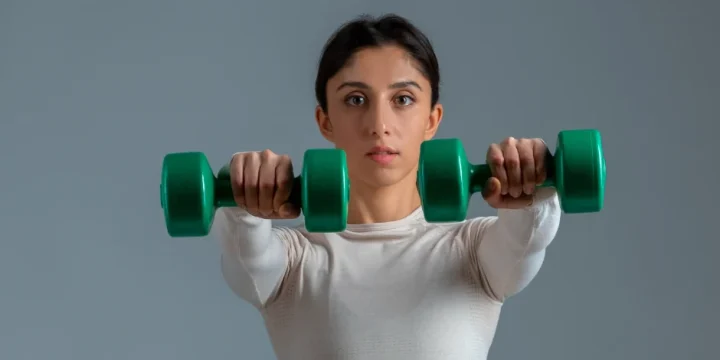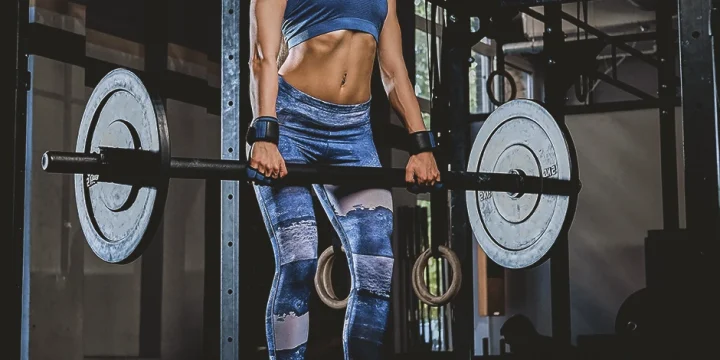While many upper-body exercises engage the triceps to some extent, they often do not fully concentrate on targeting the back of the arm.
Dumbbell triceps extension offers some variations you can incorporate into your workout routine to effectively target and isolate the tricep muscles.
As a personal trainer, I am often approached with inquiries regarding the correct technique for dumbbell tricep extensions.
I spent weeks of research delving into the proper execution of different variations, exploring the benefits of utilizing dumbbells for this exercise, and finding tips and common mistakes to avoid while performing this exercise.
Quick Summary
- The dumbbell triceps extension variations include the standing dumbbell tricep extension, the lying dumbbell tricep extension, the incline dumbbell tricep extension, the decline dumbbell tricep extension, the lying crossbody dumbbell tricep extension, and the seated one-arm dumbbell overhead tricep extension.
- To execute dumbbell tricep extensions properly, avoid head movement, incomplete range of motion, letting the elbow drift forward, keeping the elbows tucked, and refraining from lifting excessive weight.
- For effective movement, ensure a full range of motion with at least a 90-degree elbow bend during the lowering phase, which is crucial for those with weaker triceps.
- In my view, the versatility and adaptability of dumbbell tricep extensions make them an essential part of any upper-body strength training regimen.
Dumbbell Triceps Extension Variations

1. Lying Triceps Extension
How to do this exercise:
- Grasp a dumbbell in each hand and lay on a weight bench, ensuring your feet are firmly planted on the floor, vertically separated at a hip-width distance. Keep your shoulder blades and pelvis in contact with the bench throughout this exercise.
- Hold the dumbbells straight up with your arms fully extended and palms facing each other.
- Lower the weights carefully to the sides of your face while keeping the upper arms stationary.
- Return to the starting position by straightening your arms.
- Repeat until you complete three sets of twelve reps.
“If you’ve never done this exercise before, it’s advisable to begin with a light weight. That'll help you understand the movement and allow you to develop a muscle-mind connection. When you develop a muscle-mind connection with a lighter weight, it’s easier to do the same with heavier weights.”
- Shuvangi Sen Chaudhury, Fitness Editor
2. Incline Dumbbell Tricep Extensions
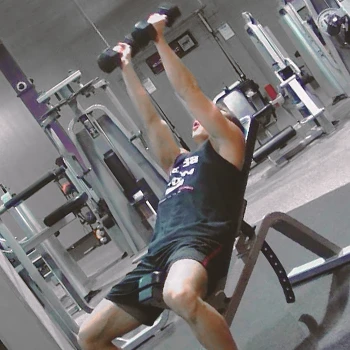
How to do this exercise:
- Hold a pair of dumbbells and sit on an incline bench (at around 45 degrees) with your back in contact with the bench and feet firmly planted on the ground.
- Raise the dumbbells to shoulder height, creating a 90-degree angle at your elbows.
- Extend your arms to drive the dumbbells up toward the ceiling.
- Flex your elbows to lower the dumbbells toward your ears.
- Pause for two seconds, then drive the weight up to return to the starting position.
- Repeat until you complete three sets of ten to fifteen reps.
3. Decline Dumbbell Tricep Extensions
How to perform this exercise:
- Adjust the bench to a decline position to allow for a better range of motion.
- Grasp a pair of dumbbells and place them on your thighs.
- Lie on the bench and grab the dumbbells while positioning your legs comfortably to the sides.
- Straighten your arms overhead, ensuring that your palms are facing each other.
- Flex your elbows to lower the dumbbells toward your ears until the face of the dumbbell faces your shoulder.
- Pause and repeat until you complete three sets of ten to fifteen reps.
4. Lying Crossbody Dumbbell Tricep Extension
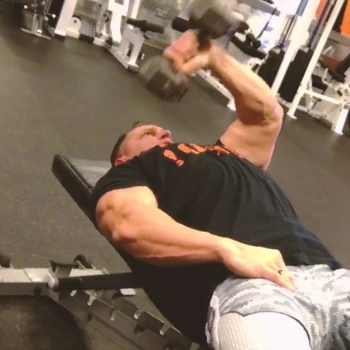
How to do this exercise:
- Take a dumbbell and lie down on a flat bench.
- Fully extend your left arm straight in front of you. Place your other arm against your left elbow for support.
- Lower the dumbbell towards your right shoulder, allowing your tricep to stretch.
- Extend your arm to return to the initial position while maintaining control and focusing on your tricep muscles to move the weights.
- Repeat until you complete three sets of fifteen reps and alternate to the other arm.
5. Standing Dumbbell Tricep Extension
How to do this exercise:
- Stand with your feet shoulder-width apart and your knees slightly bent while engaging your core.
- Bring the dumbbell above your head, keeping your wrists straight throughout the movement. Ensure that the dumbbell is facing the wall.
- Exhale as you lift the dumbbell upward while keeping your head straight.
- Hold for two seconds while focusing on squeezing your triceps.
- Inhale as you lower the dumbbell in a slow, controlled manner, stopping when your elbows reach a 90-degree angle. Ensure your elbows are tight and close to your body throughout this step.
- Repeat until you complete three sets of ten to fifteen reps.
“Resist the temptation to nod your head forward “out of the way” of the dumbbell. Lower the weight under control to avoid contacting your head or neck. Return to the overhead position when you feel a significant stretch on the triceps.”
- Chris Colucci, Fitness Expert
6. Seated One Arm Dumbbell Overhead Tricep Extension
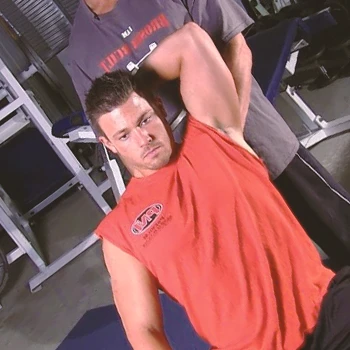
How to do this exercise:
- Choose a dumbbell with a significantly lower weight than you would use for an overhead extension.
- Sit on a weight bench, place your dumbbell overhead, and have your other arm on your waist to maintain balance and stability.
- Fully extend your arm with the dumbbell overhead while keeping your elbow close to your head and your core tight.
- Slowly lower the dumbbell to return to the starting position.
- Repeat until you complete three sets of fifteen reps and switch arms.
How to Correctly Perform Dumbbell Tricep Extensions?

As a trainer, I emphasize the importance of maintaining proper form while performing dumbbell tricep extensions.
It's crucial to avoid head movement, ensure a complete range of motion, keep the elbows from straying forward towards the face, maintain tucked elbows, and refrain from lifting excessive weight.
Head Movement
If you are new to strength training and lack upper back and shoulder mobility, it is common to experience head movement during this exercise.
To address this, I recommend opting for the lying-down variation of the exercise, as it minimizes head movement.
Ensure that your head stays aligned with the midline of your chest while keeping your chest aligned with your hips.
Maintain a forward gaze and avoid tucking your chin towards your chest to maintain proper form and prevent unnecessary pressure on your neck and back.
Incomplete Range of Motion
It is essential to perform the complete range of motion to avoid decreasing the effectiveness of this movement.
However, if your triceps are weak, you may struggle to achieve the full range of motion. Aim to achieve at least a 90-degree bend at the elbow at the lowering phase.
Related Article: Mobility Exercises to Increase Your Range of Motion
“The lowering phase should be slow and controlled, and the lifting phase should take just as long as the lowering phase. If reaching that 90-degree angle is too challenging, decrease the amount of weight that you are lifting.”
- Malia Frey, Certified Health Coach
Forward Elbow Placement
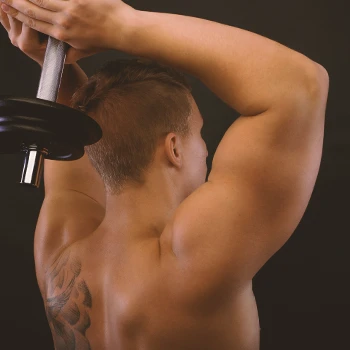
I often see a common mistake during triceps extensions: allowing the elbows to drift forward towards the face.
To correct this, I advise positioning your arms directly overhead, ensuring the biceps stay close to the ears.
Additionally, I recommend incorporating a few upper-body stretches before performing triceps extensions to properly prepare and loosen up the muscles.
Flared Elbows
When the elbows are not close to your ears, the biceps and shoulders assist in the flexion and extension, which minimizes the goal of the exercise of solely targeting your triceps.
To address this, keep your elbows tucked in and reduce the weight of dumbbells if necessary.
Lifting Excessive Weights
As you lift weight over your head, you should be very careful with the triceps extension. Select a weight you can safely control and gradually increase the resistance as you progress.
If you are pushing yourself with a higher weight increment, consider seeking assistance from a gym partner, having a spotter present, or seeking guidance from a personal trainer.
“Keep the speed of movement relatively slow, and avoid momentum to focus on your form. Also, keep your trunk stable as you lower the weight behind your back and down your spine. If the weight is too heavy or you’re fatigued, you may be tempted to arch your back, which can increase the strain on your back and shoulder joints.”
- Travis Edwards, Physical Therapist
What Are the Benefits of Using Dumbbells for Tricep Extensions?

The benefits of using dumbbells for tricep extensions are increased muscle mass, alleviated wrist stress, and enhanced posture.
Additionally, dumbbells allow higher versatility, prevent muscular imbalances, and provide greater load range.
- Increased muscle mass - Dumbbell triceps exercises are proven to efficiently engage all three heads of the triceps and maximize upper arm muscle growth. You'll gain increased muscle mass with this triceps exercise.
- Less wrist stress - Dumbbell tricep extensions offer the advantage of reducing the risk of wrist injuries. This exercise enables you to maintain a consistent wrist position throughout the entire range of motion, minimizing stress on the wrists.
- Improved posture - According to Harvard Medical School, you can experience reduced back pain and improved posture by engaging your core muscles during the standing variation of dumbbell triceps extensions [1].
- Enhanced joint health - By strengthening your tricep muscles through exercises like dumbbell tricep extensions, you can improve the stability of your elbow joints and shoulder joints.
- Higher versatility - Dumbbells offer great versatility due to their wide range of sizes and weights, allowing you to adjust the intensity of your tricep exercises and use them in different settings, whether at a gym or at home.
- Boosted muscular balance - Dumbbells can help improve muscular imbalances. You can focus on the weak side to ensure your body is equally strong and functional or use it during the recovery process from a unilateral injury.
- User-friendly - Dumbbells offer a user-friendly approach for isolating smaller muscle groups, such as the triceps.
- Greater load range - Unlike other equipment like the cable machine that may not offer such low-weight increments, dumbbells provide a wide range of weight options that allow for gradual progression, proven in one study by the National Institute of Health to increase hypertrophy and strength [2].
- Better range of motion - Dumbbells enable a full range of motion movements, allowing for a greater engagement of muscles and promoting functional strength.
Comparison With Cable Tricep Pushdowns and Skull Crushers
Dumbbell tricep extensions, cable tricep pushdowns, and skull crushers are effective tricep exercises, each with unique benefits.
- Dumbbell extensions, involving overhead movements, engage the long head of the tricep more intensely, promoting balanced muscle development. They require good shoulder mobility, making them less suitable for beginners or those with shoulder issues.
- Cable pushdowns offer constant tension through cables, leading to sustained muscle activation. They're safer and more controlled, making them ideal for all fitness levels.
- Skull crushers target all tricep heads with emphasis on the lateral head, but they can strain the elbows, so proper form and moderate weights are crucial for safety.
FAQs
Which Muscles Do Dumbbell Tricep Extensions Work?
Muscles that dumbbell tricep extensions work are the three heads of the triceps muscle (the long head, lateral head, and medial head). The anterior deltoid, pectoralis major, and forearm work as secondary muscles and are worked to a lesser extent.
Is it Better to Do Tricep Extensions Sitting or Standing?
It is better to do the standing tricep extensions as it introduces an additional challenge that requires engaging your core muscles to stabilize your lower and mid-body while simultaneously moving both arms overhead.
References:
- https://www.health.harvard.edu/healthbeat/the-real-world-benefits-of-strengthening-your-core
- https://www.ncbi.nlm.nih.gov/pmc/articles/PMC4215195/
About The Author
You May Also Like
